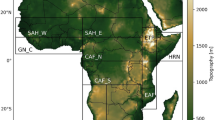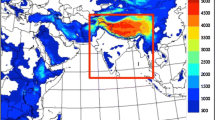Abstract
This work aims to answer if post-processing climate model outputs will improve the accuracy of climate change impact assessment and adaptation evaluation. To achieve this aim, the daily outputs of CSIRO Conformal Cubic Atmospheric Model for periods 1960–1979, 1980–1999 and 2046–2065, and observed daily climate data (1960–1979, 1980–1999) were used by a stochastic weather generator, the Long Ashton Research Station-Weather Generator to construct long time series of local climate scenarios (CSs). The direct outputs of climate models (DOCM) and CSs were then fed into the Agricultural Production System sIMulator—Wheat model to calculate seasonal climate variables and production components at three locations spanning northern, central and southern wheat production areas in New South Wales (NSW), Australia. This study firstly compared the differences in climate variables and production components derived from DOCM and CSs against those from observed climate for period 1960–1979. The impact difference arising from the use of DOCM and CSs for the future period 2046–2065 was then quantified. Simulation results show that (1) both the median/mean and distribution/variation of climate variables and production components associated with CSs were closer to those derived from observed climate when compared to those from DOCM in most of the cases (median/mean, distribution/variation, climate variables, production components and locations); (2) the difference in the mean and distribution of climate variables and production components derived from DOCM and observed climate was significant in most of the cases; (3) longer dry spells in both winter and spring were found from CSs across the three locations considered in comparison with those from DOCM; (4) the median growing season (GS) rainfall total, GS average maximum temperature, GS average solar radiation, GS length and final wheat yield were lower from DOCM than those from CSs and vice versa for GS rainfall frequency and GS average minimum temperature in 2055; (5) the mean and distribution of these climate variables and production components arising from the use of DOCM and CSs are significantly different in most of the cases. This implied that using the direct outputs of spatially downscaled general circulation model without implementing post-processing procedures may lead to significant errors in projected climate impact and the identified effort in tackling climate change risk. It is therefore highly recommended that post-processing procedures be used in developing robust CSs for climate change impact assessment and adaptation evaluation.









Similar content being viewed by others
References
Baigorria GA, Jones JW, Shin DW, Mishra A, O’Brien JJ (2007) Assessing uncertainties in crop model simulations using daily bias corrected Regional Circulation Model outputs. Clim Res 34:211–222
Baigorria GA, Jones JW, O’Brien JJ (2008) Potential predictability of crop yield using an ensemble climate forecast by a regional circulation model. Agr For Meteorol 148:1353–1361
Buser CM, Künsch HR, Schär C (2010) Bayesian multi-model projections of climate: generalization and application to ENSEMBLES results. Clim Res 44:227–241
Calanca P, Bolius D, Weigel AP, Liniger MA (2011) Application of long-range weather forecasts to agricultural decision problems in Europe. J Agr Sci 149:15–22
Carter TR, Parry ML, Harasawa H, Nishioka S. 1994. IPCC technical guidelines for assessing climate change impacts and adaptations. Special Report to Working Group II, Intergovernment Panel on Climate Change
Charles A, Timbal B, Fernandez E, Hendon H (2013) Analog downscaling of seasonal rainfall forecasts in the Murray Darling basin. Mon Weather Rev 141:1099–1117
Christensen JH, Boberg F, Christensen OB, Lucas-Picher P (2008) On the need for bias correction of regional climate change projections of temperature and precipitation. Geophys Res Lett 35:L20709
Deque M (2007) Frequency of precipitation and temperature extremes over France in an anthropogenic scenario: model results and statistical correction according to observed values. Glob Planet Chang 57:16–26
Dubrovský M, Zalud Z, Stastna M (2000) Sensitivity of CERES maize yields to statistical structure of daily weather series. Clim Chang 46:447–472
Ehret U, Zehe E, Wulfmeyer V, Warrach-Sagi K, Liebert J (2012) HESS Opinions “Should we apply bias correction to global and regional climate model data?”. Hydrol Earth Syst Sci 16(9):3391–3404
Goddard L, Mason SJ, Zebiak SE, Ropelewski CF, Basher R, Cane MA (2001) Current approaches to seasonal to interannual climate predictions. Int J Climatol 21:1111–1152
Gordon H, O’Farrell S, Collier M, Dix M, Rotstayn L, Kowalczyk E, Hirst T, Watterson I. 2010. The CSIRO Mk3.5 Climate Model. The Centre for Australian Weather and Climate Research Technical Report No. 021 Melbourne
Haerter JO, Hagemann S, Moseley C, Piani C (2011) Climate model bias correction and the role of timescales. Hydrol Earth Syst Sci 15:1065–1079
Halmstad A, Najafi MR, Moradkhani H (2013) Analysis of precipitation extremes with the assessment of regional climate models over the Willamette River Basin, USA. Hydrol Proces 27(18):2579–2590
Holzworth DP, Huth NI et al (2014) APSIM: evolution towards a new generation of agricultural systems simulation. Environ Model Softw 62:327–350
Ines AVM, Hansen JW (2006) Bias correction of daily GCM rainfall for crop simulation studies. Agric For Meteorol 138:44–53
IPCC (2001) Climate Change 2001: impacts, adaptation, and vulnerability, Cambridge University Press, London
IPCC (Intergovernmental Panel on Climate Change) (2000) Emissions scenarios. In: Nakicenovic N and R Swart (eds) Special report of the Intergovernmental Panel on Climate Change, Cambridge University Press, London
Ivanov VY, Bras RL, Curtis DC (2007) A weather generator for hydrological, ecological, and agricultural applications. Water Resour Res 43:W10406
Jeffrey SJ, Carter JO, Moodie KB, Beswick AR (2001) Using spatial interpolation to construct a comprehensive archive of Australian climate data. Environ Model Softw 16:309–330
Kim BS, Kim HS, Seoh BH, Kim NW (2007) Impact of climate change on water resources in Yongdam Dam Basin, Korea. Stoch Environ Res Risk Assess 21:355–373
Kim Y, Katz RW, Rajagopalan B, Podesta GP, Furrer EM (2012) Reduced overdispersion in stochastic weather generators using a generalized linear modeling approach. Clim Res 53:13–24
Luo Q, Yu Q (2012) Developing higher resolution climate change scenarios for agricultural risk assessment: progress. Chall Prospect Int J Biometeorol 56(4):557–568
Luo Q, Kathuria A (2013) Modelling the response of wheat grain yield to climate change: a sensitivity analysis. Theor Appl Climatol 111(1–2):173–182
Luo Q, Williams M, Bellotti WD, Bryan B (2003) Quantitative and visual assessment of climate change impacts on South Australian wheat production. Agric Syst 77:173–186
Luo Q, Wen L, McGregor JL, Timbal B (2013) A comparison of downscaling techniques in the projection of local climate change and wheat yields. Clim Chang 120(1):249–261
Luo Q, Bange M, Clancy L (2014) Cotton crop phenology in a new temperature regime. Ecol Model 285:22–29
Luo Q, Bange M, Johnston D, Braunack M (2015) Cotton water use and water use efficiency in a changing climate. Agric Ecosyst Environ 202:126–134
Maraun D, Wetterhall F, Ireson M, Chandler RE, Kendon EJ, Widmann M, Brienen D, Rust HW, Sauter T, Themeßl M, Venema VKC, Chun KP, Goodess CM, Jones RG, Onof C, Vrac M, Thiele‐Eich I. 2010. Precipitation downscaling under climate change: Recent developments to bridge the gap between dynamical models and the end user. Rev Geophys 48:RG3003. doi:10.1029/2009RG000314
McGregor JL, Dix MR (2008) An updated description of the Conformal-Cubic Atmospheric Model. In: Hamilton K, Ohfuchi W (eds) High Resolution Simulation of the Atmosphere and Ocean. Springer, New York, pp 51–76
Mearns LO, Schneider SH, Thompson SL, McDaniel LR (1990) Analysis of climate variability in general circulation models: comparison with observations and changes in variability in 2 × CO2 experiments. J Geophys Res D95:20469–20490
Mearns LO, Giorgi F, McDaniel L, Shields C (1995) Analysis of daily variability of precipitation in a nested regional climate model: comparison with observations and doubled CO2 results. Global Planet Chang 10:55–78
Mishra AK, Amor VM, Ines AVM, Singh VP, Hansen JW (2013) Extraction of information content from stochastic disaggregation and bias corrected downscaled precipitation variable for crop simulation. Stoch Environ Res Risk Assess 27:449–457
Ouyang F, Zhu Y, Fu G, Lu H, Zhang A, Yu Z, Chen X (2015) Impacts of climate change under CMIP5 RCP scenarios on streamflow in the Huangnizhuang catchment. Stoch Environ Res Risk Assess 29:1781–1795
Probert ME, Dimes JP, Keating BA, Dalal RC, Strong WM (1998) APSIM’s water and nitrogen modules and simulation of the dynamics of water and nitrogen in fallow systems. Agric Syst 56:1–28
Racsko P, Szeidl L, Semenov M (1991) A serial approach to local stochastic weather models. Ecol Model 57:27–41
Schoof JT (2008) Application of the multivariate spectral weather generator to the contiguous United States. Agric For Meteorol 148:517–521
Semenov MA, Brooks RJ (1999) Spatial Interpolation of the LARS-WG weather generator in Great Britain. Clim Res 11:137–148
Semenov MA (2007) Development of high-resolution UKCIP02-based climate change scenarios in the UK. Agric Forest Meteorol 144:127–138
Semenov MA (2008) Simulation of extreme weather events by a stochastic weather generator. Climat Res 35:203–212
Semenov MA, Brooks RJ, Barrow EM, Richardson CW (1998) Comparison of the WGEN and LARS-WG stochastic weather generators in diverse climates. Climat Res 10:95–107
Shao Q, Li M (2013) An improved statistical analogue downscaling procedure for seasonal precipitation forecast. Stoch Environ Res Risk Assess 27:819–830
Srikanthan R, McMahon TA (2001) Stochastic generation of annual, monthly and daily climate data: a review. Hydrol Earth Syst Sci 5(4):653–670
Teutschbein C, Seibert J (2012) Bias correction of regional climate model simulations for hydrological climate-change impact studies: review and evaluation of different methods. J Hydrol 456:12–29
Wang W, Wei J, Shao Q, Xing W, Yong B, Yu Z, Jiao X (2015) Spatial and temporal variations in hydro-climatic variables and runoff in response to climate change in the Luanhe River basin, China. Stoch Environ Res Risk Assess 29:1117–1133
Weiss A, Hays CJ, Won J (2003) Assessing winter wheat responses to climate change scenarios: a simulation study in the U.S. great plains. Clim Chang 58(1–2):119–147
White JW, Hoogenboom G, Kimball B, Wall GW (2011) Methodologies for simulating impacts of climate change on crop production. Field Crops Res 124:357–368
Wilby RL, Troni J, Biot Y, Tedd L, Hewitson BC, Smith DM, Sutton RT (2009) A review of climate risk information for adaptation and development planning. Int J Climatol 29:1193–1215
Wilks DS (1992) Adapting stochastic weather generation algorithms for climate change studies. Clim Chang 22(1):67–84
Wilks DS (2010) Use of stochastic weather generators for precipitation downscaling. Wiley Interdiscip Rev: Clim Chang 1(6):898–907
Wilks DS (2012) Stochastic weather generators for climate-change downscaling, part II: multivariable and spatially coherent multisite downscaling. Wiley Interdiscip Rev: Clim Chang 3(3):267–278
Acknowledgments
The author would like to thank Dr. J.L. McGregor, CSIRO Marine and Atmospheric Research, for providing the outputs of the CCAM, Dr. M. A. Semenov, Rothamsted Research, UK, for providing the LARS-WG. Dr. Anne Colville, University of Technology, Sydney, proof read this manuscript.
Author information
Authors and Affiliations
Corresponding author
Rights and permissions
About this article
Cite this article
Luo, Q. Necessity for post-processing dynamically downscaled climate projections for impact and adaptation studies. Stoch Environ Res Risk Assess 30, 1835–1850 (2016). https://doi.org/10.1007/s00477-016-1233-7
Published:
Issue Date:
DOI: https://doi.org/10.1007/s00477-016-1233-7




